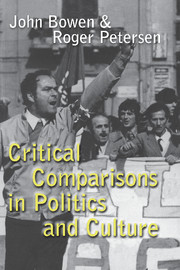Book contents
- Frontmatter
- Contents
- List of Figures
- List of contributors
- Acknowledgments
- 1 Introduction: critical comparisons
- 2 National revivals and violence
- 3 Mechanisms and structures in comparisons
- 4 Comparative methodologies in the analysis of anthropological data
- 5 The role of comparison in the light of the theory of culture
- 6 Case studies of contemporary job loss
- 7 Defining the contours of an Islamic reform movement: an essay in successive contrasts
- 8 Producing an analytic narrative
- 9 Political consciousness on Boa Ventura: 1967 and 1989 compared
- 10 Comparisons in the context of a game theoretic argument
- 11 The role of microhistories in comparative studies
- List of references
- Index of authors
- Subject index
3 - Mechanisms and structures in comparisons
Published online by Cambridge University Press: 28 January 2010
- Frontmatter
- Contents
- List of Figures
- List of contributors
- Acknowledgments
- 1 Introduction: critical comparisons
- 2 National revivals and violence
- 3 Mechanisms and structures in comparisons
- 4 Comparative methodologies in the analysis of anthropological data
- 5 The role of comparison in the light of the theory of culture
- 6 Case studies of contemporary job loss
- 7 Defining the contours of an Islamic reform movement: an essay in successive contrasts
- 8 Producing an analytic narrative
- 9 Political consciousness on Boa Ventura: 1967 and 1989 compared
- 10 Comparisons in the context of a game theoretic argument
- 11 The role of microhistories in comparative studies
- List of references
- Index of authors
- Subject index
Summary
For many central issues of comparative politics, game theory's assumption of rationality is very unrealistic. In my own work on resistance and rebellion, the importance of social norms and irrational psychological mechanisms is so obvious and important that leaving these forces unaddressed would mean forsaking the goal of descriptive validity. At a certain point, hammering a rational framework on to a non-rational reality obscures more than it enlightens. This being said, I will argue in the rest of this chapter that game theory often serves as a highly useful heuristic in approaching many of the most interesting issues of social science. In practical research, the use of game theory forces the social scientist to ask a series of “who” and “why” questions that link mechanism and structure. An explanation wedding mechanism and structure maintains causal specificity while creating the basis for prediction. Such an explanation possesses both generality and descriptive validity.
I will start with some definitions and then list three problems of a mechanism approach: “infinite regress,” lack of predictive power, inability to explain aggregate-level variation. Then I will refer to one particular “game” that has been widely used in comparative politics, then-person assurance game or “tipping model,” to illustrate how game theory can link structure to mechanism to help solve these three problems. I choose the “tipping model” because it forms a foundation for some of my own ongoing research. Conveniently, David Laitin's chapter in this volume builds from this research. In illustrating the relationships between structure, mechanism, and game theory, I will take advantage of the presence of Laitin's chapter and analyze it in some depth before turning to my own research.
- Type
- Chapter
- Information
- Critical Comparisons in Politics and Culture , pp. 61 - 77Publisher: Cambridge University PressPrint publication year: 1999
- 10
- Cited by



